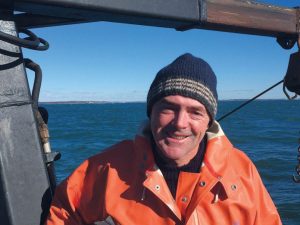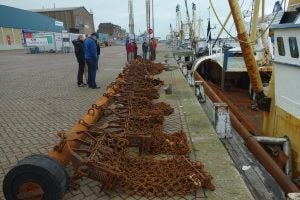 About a third of the world’s fish is caught using bottom trawling, a method that drags a net along the seabed, scooping up everything in its path.
About a third of the world’s fish is caught using bottom trawling, a method that drags a net along the seabed, scooping up everything in its path.
The ecological damage can be devastating. Many marine creatures—sea turtles, corals and anemones—are accidentally caught, and often die. As it scours the bottom, the trawl can also destroy marine habitats crucial to a thriving ecosystem.
But some trawling techniques are more damaging than others.
That’s the conclusion of a study by University of Rhode Island Oceanographer Jeremy Collie and a group of international scientists.
“Global analysis of depletion and recovery of seabed biota after bottom trawling disturbance” was published July 17 in the Proceedings of the National Academy of Science. Collie, a professor in URI’s Graduate School of Oceanography, was a co-author.
Collie and other researchers studied four different trawling techniques and concluded that otter trawling, a method that uses two doors to hold the net open, is the least harmful to marine organisms.
Collie says that the study should be of great interest to New England fisheries, which have used trawling to catch fish for decades and are often embroiled in debates with marine conservationists about whether to ban trawling, or limit the practice.
“Bottom trawling causes physical and biological change to seabed habitats and can cause structural and functional changes in seabed communities,” the scientists concluded. “Understanding the ecosystem consequences of trawling is important so we can reduce negative impacts on the seabed through appropriate management measures.”
The team looked at 70 previous studies on the effects of bottom trawling to determine which methods were most harmful. The studies focused on waters off the East Coast of the United States and Western Europe.
Besides otter trawling, the group also studied beam trawling, a method that uses a metal beam to hold the net open. The team also looked at towed dredges that drag a toothed metal bar along the seafloor and hydraulic dredges, in which a jet of water loosens the seabed to capture creatures living in the sediment.
Otter trawls removed 6 percent of marine organisms each time the net passed, according to the study. Hydraulic dredges caused the most damage, removing 41 percent of animal and plant life on the seabed, the study reports.
Depending on the type of fishing gear, penetration depth and environmental factors such as water depth and sediment composition, recovery for marine organisms ranged between 1.9 and 6.4 years.
“These findings fill an essential science gap that will inform policy and management strategies for sustainable fishing practices by enabling us to evaluate the trade-off between fish production for food and the environmental cost of different harvesting techniques,” says Ray Hilborn, a fisheries professor at the University of Washington, Seattle, and another study co-author.
The findings are part of the Trawling Best Practices Project, which is looking at the impact of trawling worldwide and hopes to publish trawling guidelines for the fishing industry that focus on preserving the marine ecosystem.
Collie expects to remain involved in the project for years to come.
“In addition to calculating the mortality of marine animals caused by bottom trawling, this study provides some of the first estimates of their rates of recovery,” he says. “Combined with high-resolution maps of trawling efforts, this work allows us to estimate the impact of bottom trawling on seafloor communities worldwide.”
 Collie collaborated with a prestigious group of scientists from various institutions including Bangor University in the United Kingdom, the Commonwealth Scientific and Industrial Research Organization in Australia, the Institute for Marine Resources and Ecosystem Studies in the Netherlands, the Alaska Fisheries Science Center in Seattle, Centro Nacional Patagonico in Argentina, and the United Nations Food and Agriculture Organization in Rome.
Collie collaborated with a prestigious group of scientists from various institutions including Bangor University in the United Kingdom, the Commonwealth Scientific and Industrial Research Organization in Australia, the Institute for Marine Resources and Ecosystem Studies in the Netherlands, the Alaska Fisheries Science Center in Seattle, Centro Nacional Patagonico in Argentina, and the United Nations Food and Agriculture Organization in Rome.
The project was funded by the David and Lucile Packard Foundation; the Walton Family Foundation; the Alaska Seafood Cooperative; American Seafoods Group; Blumar Seafoods Denmark; Clearwater Seafoods; Espersen Group; Glacier Fish Company; Gortons; Independent Fisheries New Zealand; Nippon Suisan, United States; Pacific Andes International Holdings; Pesca Chile, South Africa; San Arawa, South Africa; Sanford New Zealand; Sealord Group, New Zealand; South African Trawling Association; and Trident Seafoods.
Government funding was provided by the United Kingdom Department of Environment, Food and Rural Affairs; the European Union Project; the International Council for the Exploration of the Sea Science Fund; and the Food and Agriculture Organization of the United Nations.
Photo captions— (Top) GSO professor Jeremy Collie. (Bottom) Scallop dredges attached together on a beam at a fishing dock in the Netherlands. Photos courtesy of Jeremy Collie.
Media Contact:
Elizabeth Rau
401-874-2116
